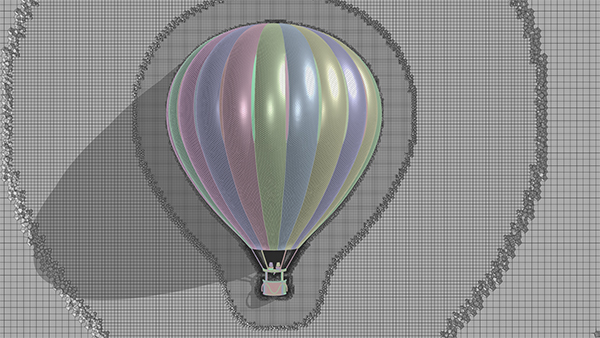Editor’s Pick: New ANSYS Release Unveils Motion Body Dynamics Line
ANSYS 2019 R1 also sees new noise-vibration-harshness workflow, multiple fluids enhancements and new metal additive manufacturing solutions.

The newly released 2019 R1 edition of the ANSYS portfolio of engineering simulation software offers new capabilities and enhancements across the entire suite of simulation and design solutions. Shown here is an example of Mosaic technology-enabled ANSYS Fluent meshing. Image courtesy of ANSYS Inc.
Latest News
February 13, 2019
Dear DE Reader:
ANSYS just introduced the 2019 R1 edition of its portfolio of engineering simulation solutions. It sounds pretty hefty for an R1 uptick. Lots going on here. For now, here's a quick tour of some highlights.
In the big picture, ANSYS 2019 R1 is like a multi-course dinner special. First, there's ANSYS Motion MBD (multibody dynamics), a completely new product line. But it isn't 1.0. This is a third-generation MBD solver developed by Virtual Motion. It provides capabilities for rigid and flexible bodies. The full product line has a bunch of application-based toolkits you can use to model complex mechanisms like drive and vehicle handling systems.

Two, ANSYS Fluent CFD (computational fluid dynamics) software dishes up a healthy serving of enhancements. In ANSYS 2019 R1 it introduces a refreshed user experience intended to speed up workflows while simultaneously making it easier to use, particularly when you generate a mesh from imported CAD designs. And workflows with parallel processing can now be used to generate Mosaic technology-enabled poly-hexcore meshes up to 10x faster than before.
Next, the ANSYS electronics and electromagnetics suite has all sorts of goodies. The ANSYS SIwave and ANSYS HFSS solutions have a new feature called EMI Scanner. You can use this to identify areas of potential electromagnetic interference on printed circuit board designs prior to simulation. Also in ANSYS SIwave, electromigration analysis capabilities help predict mean time to failure for on-chip and advanced electronic packaging structures.
A new NVH (noise-vibration-harshness) workflow debuts in ANSYS 2019 R1. What it does is couple ANSYS Maxwell, ANSYS Mechanical and the acoustic solver through ANSYS Workbench. You use it to calculate a machine's electromagnetic noise when it vibrates due to electromagnetic forces. ANSYS says that it can produce a complete noise profile of an electrical machine within hours.
Then there's a new ANSYS Additive Science exploratory environment meant to help you determine optimal process parameters for metal additive manufacturing machines and materials. ANSYS Additive Print supports more materials, and ANSYS Workbench Additive plates a new meshing option that should increase accuracy while keeping model sizes within reason.
That's not half of what ANSYS 2019 R1 brings to the table. Embedded systems, design, optics—there's new stuff everywhere. Your best bet is to hit the link at the end of today's main Editor's Pick of the Week write-up to go to a dedicated landing page where you can chow down everything ANSYS 2019 R1.
Thanks, Pal. – Lockwood
Anthony J. Lockwood
Editor at Large, DE
More Ansys Coverage
Subscribe to our FREE magazine, FREE email newsletters or both!
Latest News
About the Author
Anthony J. Lockwood is Digital Engineering’s founding editor. He is now retired. Contact him via [email protected].
Follow DE





